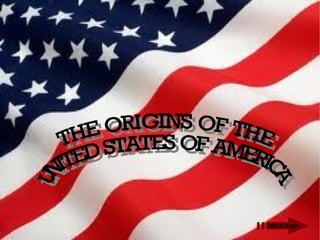
The Origins of the United States of America
- 1. NEXT SLIDE
- 2. INDEX * The first European Settlements * The thirteen Original Colonies * Independence * Expansion NEXT SLIDE
- 3. THE FIRST EUROPEAN SETTLEMENTS In 1492, Genoese explorer Christopher Columbus, under contract to the Spanish crown, reached several Caribbean islands, making first contact with the indigenous people. However, the first successful English settlements were the Virginia Colony in Jamestown in 1607 and the Pilgrims' Plymouth Colony in 1620. The 1628 chartering of the Massachusetts Bay Colony resulted in a wave of migration; by 1634, New England had been settled by some 10,000 Puritans. Between the late 1610s and the American Revolution, about 50,000 convicts were shipped to Britain's American colonies. Beginning in 1614, the Dutch settled along the lower Hudson River, including New Amsterdam on Manhattan Island. NEXT SLIDE
- 4. THE THIRTEEN ORIGINAL COLONIES The Thirteen Colonies were the colonies on the Atlantic coast of North America founded between 1607 (Virginia) and 1733 (Georgia). They revolted in the American Revolution, starting in 1775, and in 1776 declared their independence from the British Empire and formed a new nation, the United States of America. The colonies were: Delaware, Pennsylvania, New Jersey, Georgia, Connecticut, Massachusetts Bay, Maryland, South Carolina, New Hampshire, Virginia, New York, North Carolina, and Rhode Island and Providence Plantations. Each colony developed its own system of self government. The white Americans were mostly independent farmers, who owned their own land and voted for their local and provincial government. NEXT SLIDE
- 5. INDEPENDENCE (I) Tensions between American colonials and the British during the revolutionary period of the 1760s and early 1770s led to the American Revolutionary War, fought from 1775 to 1781. On June 14, 1775, the Continental Congress, convening in Philadelphia, established a Continental Army under the command of George Washington. Proclaiming that "all men are created equal" and endowed with "certain unalienable Rights", the Congress adopted the Declaration of Independence, drafted largely by Thomas Jefferson, on July 4, 1776. That date is now celebrated annually as America's Independence Day. In 1777, the Articles of Confederation established a weak confederal government that operated until 1789. NEXT SLIDE
- 6. INDEPENDENCE (II) After the British defeat by American forces assisted by the French and Spanish, Great Britain recognized the independence of the United States and the states' sovereignty over American territory west to the Mississippi River. Those wishing to establish a strong federal government with powers of taxation organized a constitutional convention in 1787. The United States Constitution was ratified in 1788, and the new republic's first Senate, House of Representatives, and president— George Washington—took office in 1789. The Bill of Rights, forbidding federal restriction of personal freedoms and guaranteeing a range of legal protections, was adopted in 1791. Attitudes toward slavery were shifting; a clause in the Constitution protected the transatlantic slave trade only until 1808. The Northern states abolished slavery between 1780 and 1804, leaving the slave states of the South as defenders of the "peculiar institution". The Second Great Awakening, beginning about 1800, made evangelicalism a force behind various social reform movements, including abolitionism. NEXT SLIDE
- 7. EXPANSION Americans' eagerness to expand westward prompted a long series of Indian Wars. The Louisiana Purchase of French-claimed territory under President Thomas Jefferson in 1803 almost doubled the nation's size. The War of 1812, declared against Britain over various grievances and fought to a draw, strengthened U.S. nationalism. A series of U.S. military incursions into Florida led Spain to cede it and other Gulf Coast territory in 1819. The Trail of Tears in the 1830s exemplified the Indian removal policy that stripped the native peoples of their land. The United States annexed the Republic of Texas in 1845, amid a period when the concept of Manifest Destiny was becoming popular. The 1846 Oregon Treaty with Britain led to U.S. control of the present-day American Northwest. The U.S. victory in the Mexican-American War resulted in the 1848 cession of California and much of the present-day American Southwest. The California Gold Rush of 1848–49 further spurred western migration. Over a half-century, up to 40 million American bison, or buffalo, were slaughtered for skins and meat and to ease the railways' spread. The loss of the buffalo, a primary resource for the plains Indians, was an existential blow to many native cultures. NEXT SLIDE
- 8. THE END (click on the flag to get more info)